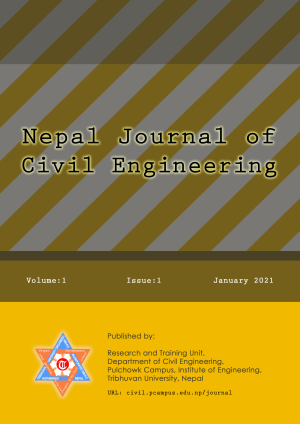Pollutant Removal Abilities of Horizontal Subsurface Flow Constructed Wetland
DOI:
https://doi.org/10.3126/njce.v1i1.43369Keywords:
BOD, Common reed, Gravel, Horizontal Subsurface Flow Constructed Wetland, Nutrients, WastewaterAbstract
With the rapid urbanization, the production of wastewater is increasing day by day. Direct discharge of wastewater in the water bodies/land causes environmental pollutions. Hence, treatment of the wastewater is must, prior to the disposal. Treatment of wastewater through constructed wetlands (CWs) require low cost, less energy consumption, easy construction, and simple operation/maintenance. So, CWs can be the better option for the developing countries such as Nepal. Main objective of the study was to determine the pollutant/nutrient removal abilities of total nitrogen (N), total phosphorous (P), potassium (K+), and biochemical oxygen demand (BOD) in the horizontal subsurface flow (HSSF) CW. The study was carried out in the HSSF CW having gravel as substrate material and common reed (narkat, phragmites karka) as macrophyte. The CW treated domestic wastewater at an average flow rate of 8.64 m3.d−1. The first order removal rate constants were 0.015 m−1 (0.200 d−1) for total N, 0.035 m−1 (0.484 d−1) for total P, 0.004 m−1 (0.052 d−1) for K+, and 0.055 m−1 (0.753 d−1) for BOD5. The influent concentration of total N, total P, K+, and BOD5 ranged from 60-100, 11-13, 34-48, and 60-120 mg.l−1, respectively; effluent concentration from 35-55, 1-3, 31-38, and 4-20 mg.l−1, respectively. Average removal efficiencies of total N, total P, K+, and BOD5 were 50.5, 75.5, 15.0, and 86.9 %, respectively. CW will be a promising option for wastewater treatment.
Downloads
Downloads
Published
How to Cite
Issue
Section
License
All the materials published in the journal are freely accessible to all. Reproduction of the part or entire content is allowed only when written consent from the publisher is obtained. The original source should be cited in reproduction as well as copying.




